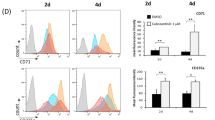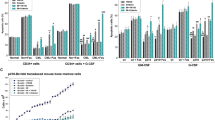Abstract
It is well established that selective COX-2 inhibitors exhibit potent effects against progression of select solid tumours. However, their effects on liquid tumours have not been fully established. By taking advantage of murine Friend Disease we have shown a strong antileukemic effect of celecoxib by determining novel in vitro targets. Western blot analyses revealed the expression of COX-2 in a panel of Friend Virus-transformed, splenic-derived primary erythroleukemic blasts and established cell lines generated in our laboratory. We have shown that celecoxib at concentrations as low as 20 μ M significantly suppresses proliferation of the selected murine erythroleukemia cell line HB60-5. The greatest proliferative inhibition was seen at 40 μ M of celecoxib, resulting in apoptosis. Our results also demonstrate that treatment of the established murine erythroleukemia cell line HB60-5 with celecoxib results in suppression of c-Kit and erythropoietin receptor (Epo-R) phosphorylation resulting in apoptosis, likely through decreased levels of survival factors. However, upon overexpression of c-Kit alone in these cells a significant increase in survival and twofold increase in proliferation in the presence of celecoxib were observed (P<0.05). Finally, since responsiveness of our murine erythroleukemia cell lines to celecoxib is above the reported physiologically achievable levels in vivo, we have provided in vitro evidence to suggest that reduced sensitivity of erythroleukemic cells to lower doses of celecoxib may be a consequence of the loss of wild-type p53. These findings are pivotal in addressing potential discrepancies associated with sensitivity of murine erythroleukemic cells to celecoxib in vitro versus in vivo.
This is a preview of subscription content, access via your institution
Access options
Subscribe to this journal
Receive 50 print issues and online access
$259.00 per year
only $5.18 per issue
Buy this article
- Purchase on Springer Link
- Instant access to full article PDF
Prices may be subject to local taxes which are calculated during checkout







Similar content being viewed by others
References
Arico S, Pattingre S, Bauvy C, Gane P, Barbat A, Codogno P and Ogier-Denis E . (2002). J. Biol. Chem., 277 (31), 27613–27621.
Bao H, Jacobs-Helber SM, Lawson AE, Penta K, Wickrema A and Sawyer ST . (1999). Blood, 39, 3757–3773.
Beazer-Barclay Y, Levy DB, Moser AR, Dove WF, Hamilton SR, Vogelstein B and Kinzler KW . (1996). Carcinogenesis, 17, 1757–1760.
Ben-David Y, Lavigueur A, Cheong GY and Bernstein A . (1990). The New Biologist, 2, 1015–1023.
Berman KS, Verma UN, Harburg G, Minna JD, Cobb MH and Gaynor RB . (2002). Clin. Cancer Res., 8, 354–360.
Bittorf T, Buchse T, Sasse T, Jaster R and Brock J . (2001). Cell Signal, 9, 673–681.
Chan G, Boyle JO, Yang EK, Zhang F, Sacks PG, Shah JP, Edelstein D, Soslow RA, Koki AT, Woerner BM, Masferrer JL and Dannenberg AJ . (1999). Cancer Res., 59, 991–994.
DuBois RN, Giardello FM and Smalley WE . (1996). Gastroenterol. Clin. North Am., 25, 773–791.
Fischer SM, Lo HH, Gordon GB, Seibert K, Kelloff G, Lubet RA and Conti CJ . (1999). Mol. Carcinog., 25, 231–240.
Giardiello FM, Hamilton SR, Krush AJ, Piantadosi S, Hylind LM, Celano P, Booker SV, Robinson CR and Offerhaus GJ . (1993). N. Eng. J. Med., 328, 1313–1316.
Harris RE, Alshafie GA, Abou-Issa H and Seibert K . (2000). Cancer Res., 60, 2101–2103.
Howard J, Ung Y, Adachi D and Ben-David Y . (1996). Cell Growth Differ., 7, 1651–1660.
Howard JC, Li Q, Chu W, Zochodne B, Kapoor M, Ung Y, Rosen K and Ben-David Y . (2001). Oncogene, 20, 2291–2300.
Hwang D, Scollard D, Byrne J and Levine E . (1998). J. Natl. Cancer Inst., 90, 455–460.
Johnson P, Chung S and Benchimol S . (1993). Mol. Cell. Biol., 13, 1456–1463.
Li YJ, Higgins RR, Pak BJ, Shivdasani RA, Ney PA, Archer M and Ben-David Y . (2001). Mol. Cell. Biol., 21, 73–80.
Lim JT, Piazza GA, Han EK, Delohery TM, Li H, Finn TS, Buttyan R, Yamamoto H, Sperl GJ, Brendel K, Gross PH, Pamukcu R and Weinstein IB . (1999). Biochem. Pharmacol., 58, 1097–1107.
Lin MT, Lee RC, Yang PC, Ho FM and Kuo ML . (2001). J. Biol. Chem., 276, 48997–49002.
Mekori YA, Gilfillan AM, Akin C, Hartmann K and Metcalfe DD . (2001). J. Clin. Immunol., 21, 171–174.
Munroe DG, Peacock JW and Benchimol S . (1990). Mol. Cell. Biol., 10, 3307–3313.
Nakanishi Y, Kamijo R, Takizawa K, Hatori M and Nagumo M . (2001). Eur. J. Cancer, 37, 1570–1578.
Sachinidis A, Gouni-Berthold I, Seul C, Seewald S, Ko Y, Schmitz U and Vetter H . (1999). Br. J. Pharmacol., 128, 1761–1771.
Shamma A, Yamamoto H, Doki Y, Okami J, Kondo M, Fujiwara Y, Yano M, Inoue M, Matsuura N, Shiozaki H and Monden M . (2000). Clin. Cancer Res., 61, 229–1238.
Shibuya T and Mak T . (1983). Proc. Natl. Acad. Sci., USA, 80, 3721–3725.
Subbaramaiah K, Altorki N, Chung WJ, Mestre JR, Sampat A and Dannenberg AJ . (1999). J. Biol. Chem., 274, 10911–10915.
Tamir A, Howard J, Higgins RR, Li YJ, Berger L, Zacksenhaus E, Reis M and Ben-David Y . (1999). Mol Cell Biol., 19, 4452–4464.
Torrance CJ, Jackson PE, Montgomery E, Kinzler KW, Vogelstein B, Wissner A, Nunes M, Frost P and Discafani CM . (2000). Nat. Med., 6, 1024–1028.
Tsujii M and DuBois RN . (1995). Cell, 83, 493–501.
Tsujii M, Kuwano S and DuBois RN . (1997). Natl. Acad. Sci., USA, 94, 3336–3340.
Williams CS, Watson AJM, Sheng H, Helou R, Shao J and DuBois RN . (2000). Cancer Res., 60, 6045–6051.
Wong KS, Li YJ, Howard J and Ben-David Y . (1999). Oncogene, 18, 5525–5534.
Zhang L, Yu J, Park BH, Kinzler KW and Vogelstein B . (2000). Science, 90, 989–992.
Acknowledgements
We are grateful for Dr R. Rottapel for his kind gift of the GP+E-86/c-Kit+, /LXS packaging cell lines. We also thank Drs J. Filmus, S. Benchimol and B. Pak for their comments concerning the work presented in this study, and also Ms. Lynda Woodcock for assistance in the preparation of the manuscript. This work was supported by a grant from the National Cancer Institute of Canada (NCIC) and a contract fund from Pharmacia/Monsanto. Dave Cervi and Amandine HL Truong are supported by studentships from the Canadian Institute for Health Research.
Author information
Authors and Affiliations
Corresponding author
Rights and permissions
About this article
Cite this article
Cervi, D., Truong, A., Lee, J. et al. Phosphorylation status of c-Kit and Epo receptors, and the presence of wild-type p53 confer in vitro resistance of murine erythroleukemic cells to Celecoxib. Oncogene 23, 2305–2314 (2004). https://doi.org/10.1038/sj.onc.1207400
Received:
Revised:
Accepted:
Published:
Issue Date:
DOI: https://doi.org/10.1038/sj.onc.1207400



